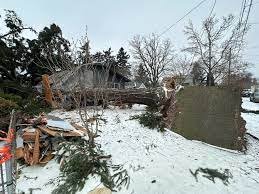Amid freezing temperatures, a significant portion of Oregon is grappling with power outages, affecting over 50,000 residents, as an arctic blast sweeps through the region. The state has already witnessed half of the 14 deaths attributed to the extreme cold. While the Pacific Northwest braces for freezing rain and ice, western Oregon, particularly Portland, Salem, and Eugene, anticipates up to half an inch of ice before a temporary reprieve.
Residents in these cities face the harsh reality of enduring frigid weather without heat due to power outages caused by a weekend storm. The severity of the weather has hampered restoration efforts, leaving many in the dark. While power outages have affected various parts of the country, Oregon stands out with more than 10,000 electric customers without power, according to poweroutage.us. Further outages are anticipated, with warnings from Portland General Electric and the National Weather Service about the likelihood of power outages and tree damage due to ice.
A 47-mile stretch of Interstate 84 connecting Portland to the Columbia River Gorge has been closed, anticipating hazardous icy conditions. Residents are strongly advised against venturing outside, even on foot, due to slick sidewalks. The Portland Oregonian’s headline reinforces this message, stating, “Get home and don’t leave: Ice storm arrives in Portland.”
The toll of the extreme weather is evident in the rising death count, with 14 fatalities linked to the arctic blast. Among these, five individuals in Oregon succumbed to hypothermia, and two were killed by falling trees. Other states also reported weather-related deaths, including a snowmobiler hit by a truck in Utah, a skier killed by an avalanche in Wyoming, and three individuals suspected of dying from hypothermia in Wisconsin. Tragically, two people in New Jersey died when their SUV collided with a snowplow on the slippery Garden State Parkway.
The widespread impact of the cold front extends beyond Oregon, affecting more than 10,500 flight delays or cancellations and disrupting travel plans for over 36,000 instances during the Martin Luther King holiday weekend. Millions of students from various cities, including Portland, Chicago, Denver, Dallas, and Baltimore, have had their classes canceled, with further closures expected on Wednesday.
Authorities in Texas and the Tennessee Valley have urged residents to voluntarily reduce electricity consumption to avoid blackouts caused by high demand. In Kentucky, a daring rescue mission was conducted to extricate four hikers trapped in the Red River Gorge, described as “one of the most dangerous rescues ever attempted.”
The frigid conditions have swept across three-quarters of the United States, affecting approximately 68 million Americans. Cities like New York, Philadelphia, Baltimore, and Washington, D.C., have seen an end to snow droughts lasting almost two years, with subfreezing temperatures forecast for much of the nation. A wall of bitter cold temperatures, ice, and snow has led to the closure of federal government offices, chaotic travel, and gleeful students being kept out of schools.
In Tennessee, an unexpected 8 inches of snow paralyzed Nashville, where the annual snowfall average was only 4.7 inches. The wintry precipitation along the Atlantic and Pacific coasts, coupled with frigid Arctic air, has created challenging conditions. Even cities with historically low snowfall, like Washington, D.C., experienced over 1 inch of snow for the first time in approximately two years.
While a brief reprieve is expected midweek, another surge of arctic air is forecast to sweep across the Plains and Deep South by Thursday or Friday, potentially bringing more challenges. The weekend may witness another arctic blast impacting the central and eastern U.S., albeit less intensely than the ongoing cold wave.
As the nation grapples with the fallout from this extreme weather event, communities, and individuals are facing significant disruptions, prompting a collective effort to cope with the harsh conditions and support those in need.
